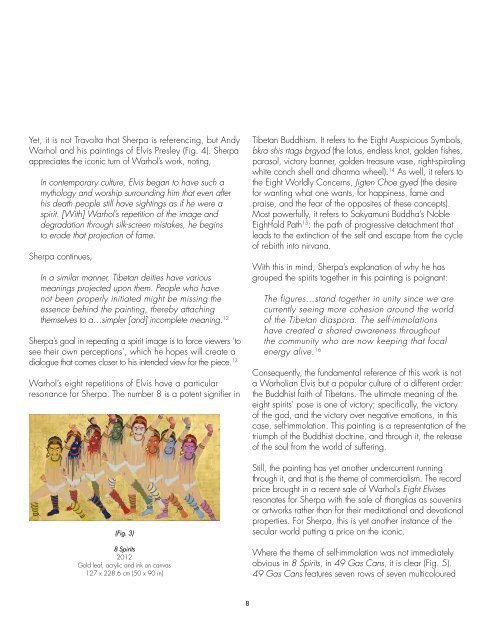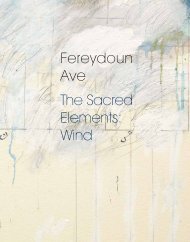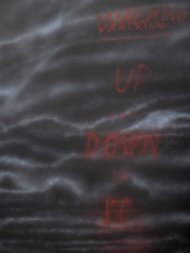Tsherin Sherpa Tibetan spirit
Tsherin Sherpa - Tibetan Spirit - Rossi & Rossi
Tsherin Sherpa - Tibetan Spirit - Rossi & Rossi
- No tags were found...
Create successful ePaper yourself
Turn your PDF publications into a flip-book with our unique Google optimized e-Paper software.
Yet, it is not Travolta that <strong>Sherpa</strong> is referencing, but Andy<br />
Warhol and his paintings of Elvis Presley (Fig. 4). <strong>Sherpa</strong><br />
appreciates the iconic turn of Warhol’s work, noting,<br />
In contemporary culture, Elvis began to have such a<br />
mythology and worship surrounding him that even after<br />
his death people still have sightings as if he were a<br />
<strong>spirit</strong>. [With] Warhol’s repetition of the image and<br />
degradation through silk-screen mistakes, he begins<br />
to erode that projection of fame.<br />
<strong>Sherpa</strong> continues,<br />
In a similar manner, <strong>Tibetan</strong> deities have various<br />
meanings projected upon them. People who have<br />
not been properly initiated might be missing the<br />
essence behind the painting, thereby attaching<br />
themselves to a…simpler [and] incomplete meaning. 12<br />
<strong>Sherpa</strong>’s goal in repeating a <strong>spirit</strong> image is to force viewers ‘to<br />
see their own perceptions’, which he hopes will create a<br />
dialogue that comes closer to his intended view for the piece. 13<br />
Warhol’s eight repetitions of Elvis have a particular<br />
resonance for <strong>Sherpa</strong>. The number 8 is a potent signifier in<br />
(Fig. 3)<br />
8 Spirits<br />
2012<br />
Gold leaf, acrylic and ink on canvas<br />
127 x 228.6 cm (50 x 90 in)<br />
<strong>Tibetan</strong> Buddhism. It refers to the Eight Auspicious Symbols,<br />
bkra shis rtags brgyad (the lotus, endless knot, golden fishes,<br />
parasol, victory banner, golden treasure vase, right-spiraling<br />
white conch shell and dharma wheel). 14 As well, it refers to<br />
the Eight Worldly Concerns, Jigten Choe gyed (the desire<br />
for wanting what one wants, for happiness, fame and<br />
praise, and the fear of the opposites of these concepts).<br />
Most powerfully, it refers to Sakyamuni Buddha’s Noble<br />
Eight-fold Path 15 : the path of progressive detachment that<br />
leads to the extinction of the self and escape from the cycle<br />
of rebirth into nirvana.<br />
With this in mind, <strong>Sherpa</strong>’s explanation of why he has<br />
grouped the <strong>spirit</strong>s together in this painting is poignant:<br />
The figures…stand together in unity since we are<br />
currently seeing more cohesion around the world<br />
of the <strong>Tibetan</strong> diaspora. The self-immolations<br />
have created a shared awareness throughout<br />
the community who are now keeping that focal<br />
energy alive. 16<br />
Consequently, the fundamental reference of this work is not<br />
a Warholian Elvis but a popular culture of a different order:<br />
the Buddhist faith of <strong>Tibetan</strong>s. The ultimate meaning of the<br />
eight <strong>spirit</strong>s’ pose is one of victory; specifically, the victory<br />
of the god, and the victory over negative emotions, in this<br />
case, self-immolation. This painting is a representation of the<br />
triumph of the Buddhist doctrine, and through it, the release<br />
of the soul from the world of suffering.<br />
Still, the painting has yet another undercurrent running<br />
through it, and that is the theme of commercialism. The record<br />
price brought in a recent sale of Warhol’s Eight Elvises<br />
resonates for <strong>Sherpa</strong> with the sale of thangkas as souvenirs<br />
or artworks rather than for their meditational and devotional<br />
properties. For <strong>Sherpa</strong>, this is yet another instance of the<br />
secular world putting a price on the iconic.<br />
Where the theme of self-immolation was not immediately<br />
obvious in 8 Spirits, in 49 Gas Cans, it is clear (Fig. 5).<br />
49 Gas Cans features seven rows of seven multicoloured<br />
gasoline cans. Each can is in a different colour, and each<br />
bears the face of a wrathful protector <strong>spirit</strong>. The <strong>spirit</strong>s’ faces<br />
are painted in ghostly white outline, enmeshed in the starshaped<br />
thik tse grid measurement. This grid is an element<br />
taken from the traditional <strong>Tibetan</strong> painting technique for<br />
establishing the correct scale and form of icons.<br />
The separate paper sheets for the cans represent traditional<br />
square or rectangular <strong>Tibetan</strong> prayer flags. The cans’ repeated<br />
order from yellow, purple, red, green, orange, blue and<br />
pink, and back again in alternating rows, suggests the flags<br />
flapping in the wind, disseminating prayers through space.<br />
As the colours are not strictly traditional, however, they<br />
represent an adjustment to the iconography. Whereas traditional<br />
prayer flags are always in yellow, blue, red, green<br />
and white colours, 17 here, the purple, orange and pink are<br />
new additions to the form. That the white flag is not present<br />
is not a comment on what white can symbolise, but rather a<br />
comment on shifting <strong>Tibetan</strong> needs. Nonetheless, <strong>Sherpa</strong>’s<br />
reference is more ideological than specific, and as such<br />
represents the concept of a new and modern prayer flag<br />
responding to new and modern prayers. 18<br />
The new iconography of the prayer flags cum gas cans is<br />
a clear-cut response to <strong>Tibetan</strong> self-immolation. Moreover,<br />
in this painting, <strong>Sherpa</strong>’s forty-nine gas cans represent the<br />
forty-nine days of formal Buddhist prayer ceremonies that<br />
are held after a person dies and whilst waiting for the soul<br />
to decide to reincarnate or attain nirvana. 19<br />
The phenomenon of self-immolation is new to <strong>Tibetan</strong> society.<br />
It was only in 1998 that the first <strong>Tibetan</strong> auto-cremated. 20<br />
Yet, at the time of writing, already more than fifty <strong>Tibetan</strong><br />
monks, nuns and laity throughout the world have<br />
extinguished themselves in flame. As <strong>Tibetan</strong> Buddhism<br />
scholar Janet Gyatso explains, “Today the target of Tibet’s<br />
recent self-immolations is an outer enemy: an intrusive, repressive,<br />
unsympathetic state” of the People’s Republic of<br />
China. This is in contrast to the traditional form of ascetic<br />
practice, which “targeted an inner enemy: selfish clinging,<br />
vanity, enmity”. 21<br />
(Fig. 4)<br />
Andy Warhol<br />
Eight Elvises<br />
1963<br />
Silk-screen ink, silver paint and spray paint on linen<br />
208 x 358 cm (82 x 141 in)<br />
© The Andy Warhol Foundation for the Visual Arts / Artists Rights Society<br />
(ARS), New York/DACS, London 2012. Reproduction taken from Phaidon<br />
Editors, Steven Bluttal & Dave Hickey, Andy Warhol “Giant” Size, London:<br />
Phaidon Press, 2006, p.197.<br />
Not on view in the current exhibition<br />
12<br />
<strong>Sherpa</strong>, email to the author, 5 September 2012.<br />
13<br />
<strong>Sherpa</strong>, email to the author, 5 September 2012.<br />
14<br />
Robert Beer, The Encyclopedia of <strong>Tibetan</strong> Symbols<br />
and Motifs, Boston: Shambala Publications, Inc.,<br />
1999, pp. 171–87.<br />
15<br />
Sakyamuni Buddha preached that the Noble<br />
Eight-fold Path is attainable through the Right Views<br />
(i.e., the understanding of suffering and its cause), Right<br />
Resolve, Right Speech, Right Conduct (moral life), Right<br />
Livelihood (preferably the monastic life), Right Effort<br />
(the maintenance of will power), Right Mindfulness (the<br />
examination and evaluation of one’s progress) and<br />
Right Meditation, where meditation is the final step and<br />
the only means leading ultimately to enlightenment.<br />
16<br />
<strong>Sherpa</strong>, email to the author, 5 September 2012.<br />
17<br />
<strong>Sherpa</strong> explains that the five colours of the<br />
traditional prayer flag represent the Five Enlightened<br />
Buddha Families (Nampar nangdze/Nam namg<br />
[Sk: Vairocana]; Mitrugpa [Sk: Akṣhobhya],<br />
Wöpakme [Sk: Amidtābha], Rinchen Jung ne/Rin<br />
jung [Sk: Ratnasaṃbha] and Dön yö drub pa/Dön<br />
drub [Sk: Amoghasiddhi]); the Five Directions and<br />
the Five Elements (earth, space, fire, air and water).<br />
<strong>Sherpa</strong>, email to the author, 24 August 2012; Beer,<br />
The Encyclopedia of <strong>Tibetan</strong> Symbols and Motifs,<br />
pp. 90–93.<br />
18<br />
<strong>Sherpa</strong>, email to the author, 24 August 2012.<br />
19<br />
<strong>Sherpa</strong>, interview with the author, 4 August 2012.<br />
20<br />
Thubten Ngodup, a <strong>Tibetan</strong> layman living in exile<br />
in India, put himself to the flame in New Delhi in<br />
1998. Edward Wong, ‘<strong>Tibetan</strong> Who Sets Himself<br />
Afire Dies’, The New York Times, 17 March 2001,<br />
www.nytimes.com /2011/03/18/world/<br />
asia/18tibet.html, accessed 4 September 2012.<br />
21<br />
Janet Gyatso, quoted in Asia Sentinel, 3 September<br />
2012, http://asiasentinel.com/index.php?option<br />
=com_ content&task =view&id=4789&Itemid =189,<br />
accessed 4 September 2012.<br />
8<br />
9











